990FX Motherboard Roundup with Thuban and Bulldozer – A Second Wind for ASUS, Gigabyte, MSI and Biostar
by Ian Cutress on April 5, 2012 11:00 AM ESTTest Setup
| Processor |
AMD Phenom II X6 1100T (6C, 3.3 GHz) AMD FX-8150 (8C, 3.6 GHz) |
| Motherboards |
($230) ASUS Crosshair V Formula (990FX) ($185) ASUS Sabertooth 990FX ($180) Gigabyte 990FXA-UD5 ($195) MSI 990FXA-GD80 ($130) Biostar TA990FXE |
| Cooling | AMD All-In-One Liquid Cooler, made by Asetek |
| Power Supply | Silverstone 1000W 80 PLUS Silver |
| Memory |
Patriot Viper Extreme 2x4 GB DDR3-2133 9-11-9 Kit GSkill RipjawsX 4x4 GB DDR3-1866 9-10-9 Kit |
| Memory Settings | Default |
| Video Cards |
XFX HD 5850 1GB ECS GTX 580 1536MB |
| Video Drivers |
Catalyst 11.8 NVIDIA Drivers 285.62 |
| Hard Drive | Micron RealSSD C300 256GB |
| Optical Drive | LG GH22NS50 |
| Case | Open Test Bed - CoolerMaster Lab V1.0 |
| Operating System | Windows 7 64-bit |
| SATA Testing | Micron RealSSD C300 256GB |
| USB 2/3 Testing | Patriot 64GB SuperSonic USB 3.0 |
System Power Consumption
Power consumption was tested on the system as a whole with a wall meter connected to the power supply, while in a dual GPU configuration. This method allows us to compare the power management of the UEFI and the board to supply components with power under load, and includes typical PSU losses due to efficiency. These are the real world values that consumers may expect from a typical system (minus the monitor) using this motherboard.
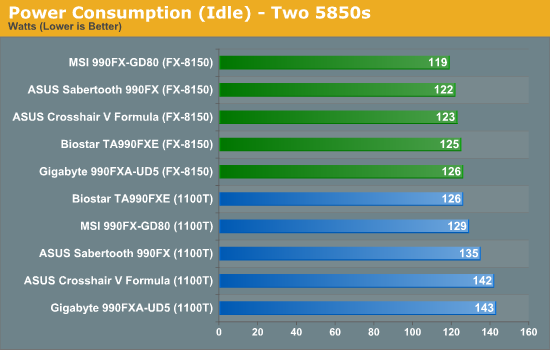
In idle power consumption, the FX-8150 with its newer architecture is able to more efficiently power gate itself. The Gigabyte board comes last on both processors, while the MSI has a good showing.
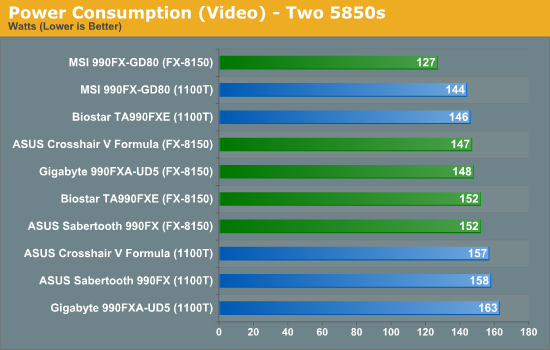
In video mode, it's all about how the motherboard decides to activate cores and/or turbo modes. Again, the FX-8150 seems to be the (in general) processor of choice, with the MSI again taking command of low power usage.
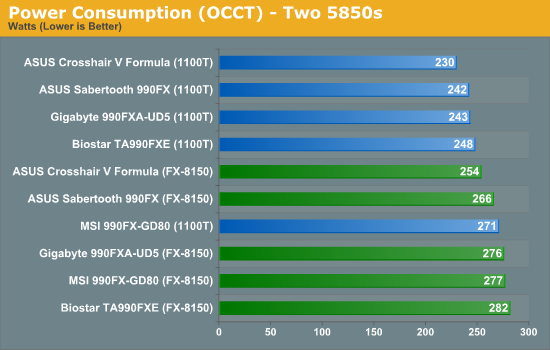
For OCCT, our CPU stress test, the FX-8150 starts to draw that extra power it needs. In this circumstance, the ASUS boards tend to use less power under either processor than their competitors.
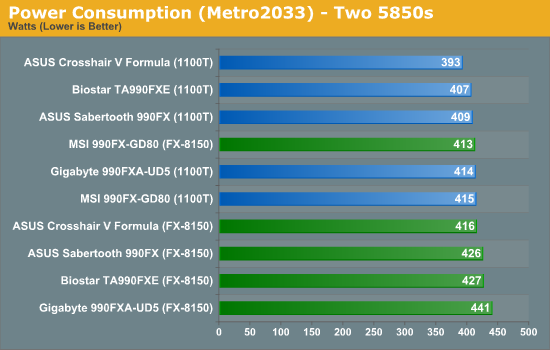
In the case of Metro2033, as both GPUs are running equally at large load, it is all about how the motherboard decides to power up the CPU and assign turbo states. The Crosshair V Formula performs well on both processors.
CPU Temperatures
With most users’ running boards on purely default BIOS settings, we are running at default settings for the CPU temperature tests. This is, in our outward view, an indication of how well (or how adventurous) the vendor has their BIOS configured on automatic settings. With a certain number of vendors not making CPU voltage, turbo voltage or LLC options configurable to the end user, which would directly affect power consumption and CPU temperatures at various usage levels, we find the test appropriate for the majority of cases. This does conflict somewhat with some vendors' methodology of providing a list of 'suggested' settings for reviewers to use. But unless those settings being implemented automatically for the end user, all these settings do for us it attempt to skew the results, and thus provide an unbalanced 'out of the box' result list to the readers who will rely on those default settings to make a judgment. CPU Temperatures are not really indicative of quality or performance, even though one would postulate that worse parts may produce higher temperatures. However, if a manufacturer uses more conductive material in the power plane, this reduces resistance and increases the voltage at the CPU, causing a higher temperature but potentially better stability.
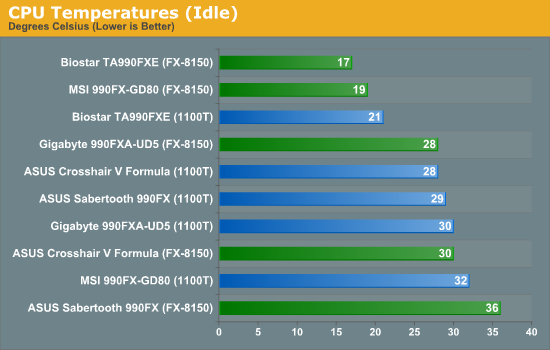


Analysing CPU temperatures is an observational science under our methodology, restricted by the fact that different motherboards use different sensors to report the temperature - some use the response back from the CPU to show temperature, while some connect themselves to onboard sensors. This has a direct result on any default fan profiles, as the Gigabyte board gave us almost zero fan speed while at idle, indicating perhaps a quieter (but potentially hotter) system. The Biostar seems to take advantage of this the most to represent the lower temperature (possibly to confuse reviewers...?), or there is a slight mis-calibration on the sensor readouts.










57 Comments
View All Comments
Mathieu Bourgie - Friday, April 6, 2012 - link
Here's hoping*john21108 - Friday, April 6, 2012 - link
I read the review and didn't see the FX-6200 getting walked over. The benches were all pretty close; the FX, X4, and the X6 all trading blows. At worse, the FX-6200 performed similar to the X4 980; at best, it would barely beat the X6 1100T.The FX looked good to me considering the X6 1100T is going for $240+ on eBay. If building new, is same performance worth an extra $70? Is it an upgrade to an X4 BE or X6, no.
estarkey7 - Thursday, April 5, 2012 - link
I am disappointed in this article for a number of reasons, most of all that the preface of this article had very little to do with the content at all. You start off by stating:"...despite the fact that Windows 7 (and Windows 8, natively) is now receiving updates so the operating system can understand the processor architecture a little better, and hopefully boost performance. This gives a second wind to those owning (or thinking of owning) a Bulldozer based processor, and in turn, a 900-series motherboard."
With that being a defining point of this article, where are before and afters? I and everybody else on here already know what Anand did (hell, we read this site multiple times a day!). Why should I give this platform a second look?. Your preface led me to believe that I would see benches of these motherboards before and after firmware revisions or more importantly firmware revisions and Win 7 vs. Win 8 preview.
It doesn't even make sense to run a full set of benches against motherboards with the same processor at stock speeds, as the differences will surely show in their overclocking potential and feature sets.
Do you even realize that after reading this article that every single reader of Anandtech.com learned absolutely, positively nothing about Bulldozer vs. Thurban vs. Intelxxx that they didn't already know before they wasted 15 minutes of their time?
Why not just delete it, and we'll forget you ever wrote it...
IanCutress - Thursday, April 5, 2012 - link
The purpose of the review was to look at the motherboards and the differences between them, not the absolute performance of the processors. Hence why this review is listed under the motherboard section rather than the CPU section, and the paragraph you quoted ended with the phrase, with appropriate pauses to create emphasis on, 'a 900-series motherboard'. The initial paragraph created purpose and the fact that there is reason to perhaps own one of these motherboards, generating the context and situation to which they are currently in.Anyway, as a regular reader of Anandtech, surely you recognise me as the motherboard reviewer for the past year or more? :)
Ian
estarkey7 - Thursday, April 5, 2012 - link
Ian,I let my recent bulldozer system build get the best of me!
I retract my statement. I believe my attack on you was not reasonable and served no purpose. Although I do disagree with some of the phrasing in the intro paragraph, my post was not warranted and I sincerely apologize.
Keep up the good work.
Ed
Dekkatek - Thursday, April 5, 2012 - link
I don't know if anyone else noticed this, but there is a galler pic of the ASUS Crosshair board with a 4 video card setup and the 4th card is not physically connected to the motherboard!http://www.anandtech.com/Gallery/Album/1843#13
IanCutress - Thursday, April 5, 2012 - link
Haha nice catch :) Most of those images are from ASUS' media kit for the board - I think I must have looked at it and thought they were using the ROG Xpander for four-way. Looking at the Xpander page now, it was only ever compatible on the R3E and R3F.Ian
Makaveli - Thursday, April 5, 2012 - link
When did you need a $1000 extreme edition cpu to be an enthusiast.I'm not really sure what point you are trying to make.
A i7 920 a 2500k or 2600k are all enthusiast cpu that cost less than $400. And all outperform AMD current line up.
It like you are trying to be like AMD before they launched BD comparing it the 990x and saying look out processor is better and doesn't cost $1000 don't make me laugh.
If you are gonna troll you better start doing a better job.
cocoviper - Thursday, April 5, 2012 - link
$1000? Try any CPU over $240.http://www.anandtech.com/show/4955/the-bulldozer-r...
http://leapvine.com/p/1237/Intel%20Core%20i7-2600%...
CPU price ranges tend to range between $50 and $1000 in the retail market. AMD's fastest solution captures the lowest 25% of this market, leaving 3/4 of the price range, and the range with the best margins, to Intel. We all want AMD to be competitive again like they were in the late 90s/early 2000s but they simply aren't.
AMD has also officially stated they have no intention to compete in the performance / enthusiast segment. Per Anand:
"As AMD's client strategy is predominantly built around APUs, the only high-end desktop parts we'll see from AMD are low-end server CPUs. Socket-AM3+ has a future for one more generation and we'll likely see other single-socket, high-end platforms for the desktop. The days of AMD chasing Intel for the high-end desktop market are done though. That war is officially over."
http://www.anandtech.com/show/5503/understanding-a...
BaronMatrix - Thursday, April 5, 2012 - link
Why doesn't anyone use the recommended GPU? If I buy an 8150, it will at least get a 6970 but probably a 7970.No wonder I left this "review site" stuff alone. I can't learn anything except that people think there are 50 CPU makers and AMD is the worst.
Good luck with that.